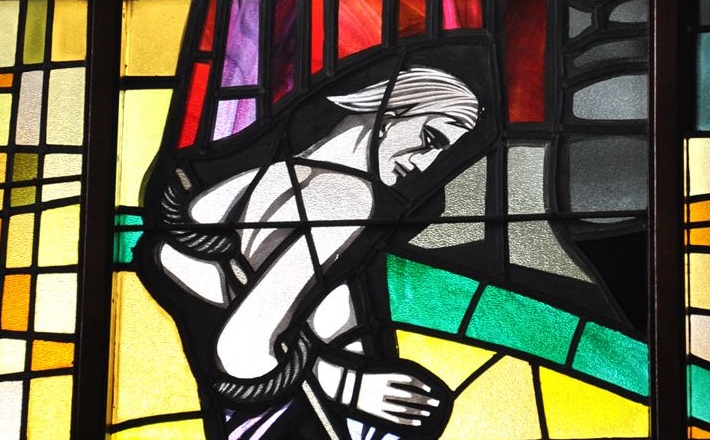Commentary on Genesis 3:8-15
Reading the Genesis 3 text in light of Jesus’ confrontations with people who thought he was “out of his mind,” focuses our attention on expectations about the relationships between God and humans, and humans and creation.*
From the beginning of this scene — before we arrive at the articulated differences between God and the humans — we hear an astonishing aspect of their relationship. The first sentence tells us that the Lord God walks in the garden. God has come to the place where people are living. It is a pleasant scene in which God walks in the evening breeze without a hint of what seems a bitter denunciation to come. God seeking-out-creation governs the action.
The story then gives us a number of pithy theological questions to ponder. Since God seems not to know where the humans are, does this mean God is not omniscient? When the human explains he was afraid because of his nakedness, does he not know that God will find this strange? How did the human even know there is something to fear in being naked?
God asks the sensible question: How did you know you should hide? Not waiting for an answer, God drives immediately to the suspicion that the knowledge of good and evil has come into the human: “Have you eaten from the tree…?”
This story is hard to hear without centuries of built-up prejudices ruling the interpretation. In order to let the gospel rise to the surface, we have to expunge the ideas that this story tells us the woman is inferior and the snake is despicable. How can we do that?
Rather than seeing this story as depicting necessary dualism between human and divine, human and nature, good and evil, knowledge (bad) and ignorance (bliss), we might notice the harm that comes from such simplistic readings. Seeing the story only through the structures of oppositions leads to divisive and untrue views of creation.
1) Pointedly, the story does not say the woman is a vixen for suggesting that the fruit should be eaten nor is she inferior to the man. If we see the woman in Genesis 3 through the view of her creation as the “helper” (Genesis 2:18), and we define “helper” as a subordinate creature (i.e., he initiates; she obeys or follows), we ignore the more generous interpretation offered by the word “helper” when it is used to refer to God.1
2) We might note that this story shows us the possibility that truth does not come only from the divine but from what God has created: the snake, the tree, and the initiative — the daring — of the woman in taking a risk.2
3) Try shedding the notion that the “fall” story is about sin — especially sexual sin — and the shame of the naked body. Try on the notion that gaining the knowledge given by the forbidden tree allows the humans to differentiate themselves from the rest of nature. This self-image is necessary for stewardship and care of creation. It also opens the opportunity to know God’s goodness in clothing them (Genesis 3:21-22).3 “Once the human beings have shown themselves willing to transgress the boundaries of God, nakedness becomes frightening, since even the boundaries of their bodies no longer seem secure.”4 Blame is their response to fear of vulnerability rather than shame.
4) See what difference it makes to reinterpret the snake’s qualities. The Hebrew word for what NRSV calls “cunning” is arum which can also be crafty and prudent (Proverbs 12:16) and clever (Proverbs 12:23; 13:16; 14:8; and 22:3). We speak of cunning in negative terms while clever is positive. The snake did not simply cause disobedience but put an end to uncritical obeisance. Consider whether asking a question is evidence of evil, for that is what the snake, in fact, does. Asking what God really said is not the symbol of demonic powers but, rather, using one’s intelligence.5
5) This Genesis story sets the stage for the vocation of the faithful. In the garden, when confronted with their fear [of nakedness, of vulnerability, of non-differentiation from animals because they are not yet clothed], the humans seek to place blame on someone other than themselves. The adam (creature of dust) blames the woman, and the woman blames the snake. As a story depicting human reaction to threats, this scene is perfect. What, if not blame of others, do humans exercise when they are attacked? What, if not oppression of the foreigner, do nations initiate when scared? We have come a long distance from the beginning of this scene. No longer is creation simply a garden in which the creator walks in the evening breeze. Trouble has appeared.
Jesus’ way is markedly different from that of the humans in Genesis 3. Jesus re-defines kinship, saying that his family is neither based in biology nor comprised of people like himself: fellow rabbis and theologians. His family are those who do “the will of God.” He challenges the expected structures of relationship and of power, creating community out of relationships centered in God. The Old Adam and the New Adam stand in stark contrast. Jesus “refuses the idolatry of security.”6
It remains for us humans to acknowledge our fear and, clothed with the garments of God’s care for us, to see how we might respond with our weaknesses rather than by asserting power over others. How might such a posture alter our relationships with Earth (and even snakes!)?
1Cf. Hosea 13:9; Exod. 18:4; Deut 33:26; Pss. 146:5; 33:20; 115:9-11; 70:5.
2Robert Saler, “The Transformation of Reason in Genesis 2-3,” in Currents in Theology and Mission 36:4 (Aug 2009), 283-284.
3R.A. Oden, “Grace or Status, Yahweh’s Clothing of the First Humans,” in The Bible Without Theology (San Francisco: Harper & Row, 1987), 102-103.
4Scott Bayder-Saye, “Fear in the Garden: The State of Emergency and the Politics of Blessing,” in Ex Auditu 24 (2008), 5.
5Arthur Walker-Jones, “Eden for Cyborgs: Ecocriticism and Genesis 2-3,” in Biblical Interpretation 16 (2008), 263-293.
6Bayder-Saye, 11.
* This commentary was first published on this site on June 10, 2012.


June 7, 2015